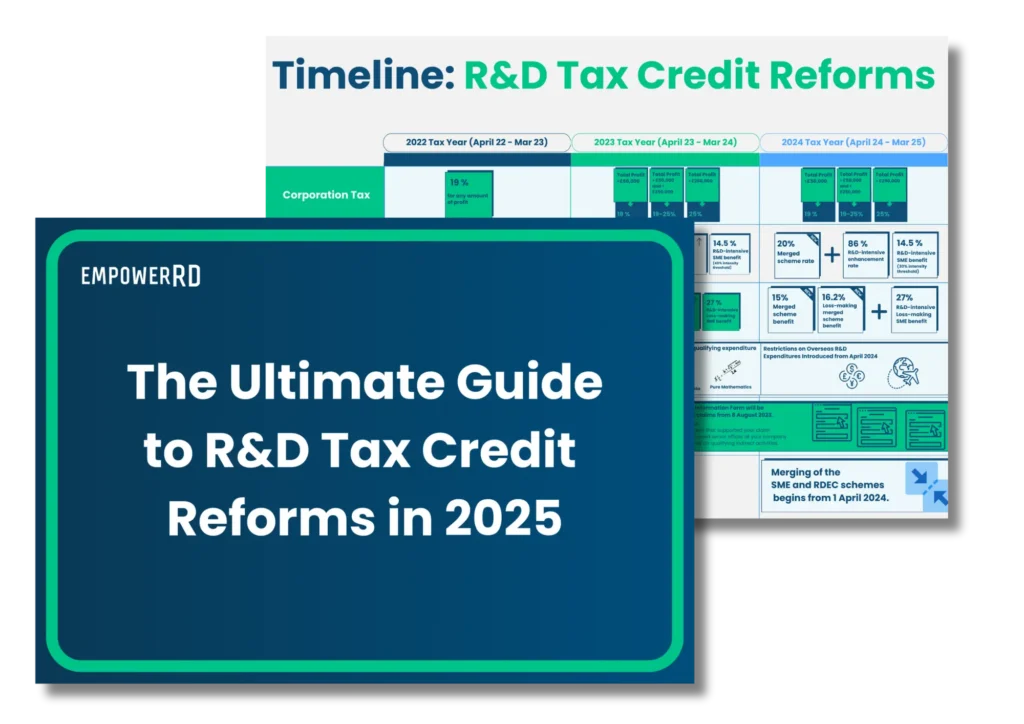Introduction
In the ever-changing business landscape, Research and Development (R&D) serves as the driving force behind innovation and progress. It is the key that unlocks the potential for companies to redefine industries, enhance customer experiences, and solidify their market positions.
This sentiment is strongly supported by companies in the UK, as indicated by the latest data from The Office of National Statistics. In 2021, UK businesses invested a staggering £46.9 billion in R&D, demonstrating their commitment to staying at the forefront of technological advancements.
This article will delve into the critical role that R&D plays in business growth strategies, its profound impact on gaining a competitive advantage, and the exciting opportunities it presents in today’s rapidly evolving global market.
The Importance of a good Research and Development (R&D) strategy
R&D is the lifeblood of innovation, fueling advancements in technology, product design, and service delivery. It’s the force that drives businesses to think beyond the status quo, pushing boundaries, and unlocking new possibilities. For small businesses in the UK, Research and Development activities are not a luxury but a necessity for survival and growth.
Innovation through R&D can lead to several key benefits for small UK businesses:
- Competitive Edge: R&D efforts enable businesses to stay ahead of competitors by introducing novel products or services that captivate customers and carve out unique market positions.
- Market Expansion: R&D helps identify opportunities for diversification and market expansion, opening doors to new customer segments and revenue streams.
- Cost Efficiency: Through R&D, businesses can discover more efficient processes, reducing operational costs and improving profitability.
- Adaptation to Regulatory Changes: In a rapidly changing regulatory environment, R&D is essential for businesses to adapt and remain compliant.
The impact of budget constraints on R&D
While the merits of R&D are undeniable, the path to innovation is often fraught with challenges, and one of the most formidable obstacles is budget constraints. Small businesses, in particular, frequently find themselves grappling with limited financial resources, making it increasingly challenging to invest in R&D initiatives that are essential for sustainable growth.
Understanding R&D Strategy
Defining R&D strategy
At its core, a research and development strategy is a roadmap that defines how a business plans to harness its resources and expertise to innovate, develop new products or services, and remain competitive, whether that’s a technology company or an aerospace business. It outlines the goals, priorities, and methods for achieving technological advancements and market differentiation. For small businesses in the UK, defining a clear R&D strategy is akin to charting the course for success.
The Role of R&D in innovation and competitiveness
Innovation is the cornerstone of competitiveness in the modern business landscape. R&D plays a pivotal role in fostering innovation by facilitating the exploration of uncharted territories, refining existing offerings, and the development of cutting-edge solutions. For small businesses, R&D isn’t just an avenue for keeping up with larger competitors—it’s a means to surpass them.
Aligning R&D with business goals
The efficacy of an R&D strategy hinges on its alignment with the overarching objectives of the business. When R&D efforts harmonise with core business goals, the impact can be transformational. This section will explore the importance of synergy between R&D and business strategy and provide insights into how small UK businesses can ensure that their R&D initiatives are well-integrated and focused on achieving tangible outcomes.
Steps to Creating an Effective R&D Strategy
Assessing current R&D capabilities
- Analysing existing resources: Before embarking on any strategic initiative, it’s essential to conduct a comprehensive assessment of available resources. This includes financial assets, existing technologies, infrastructure, and intellectual property. Understanding what you have at your disposal allows you to set realistic goals and identify areas needing additional investment.
- Evaluating talent and expertise: The success of R&D largely depends on the talent driving it. Assess the skill sets within your team. Do you have the right mix of researchers, scientists, engineers, support staff and development team? Recognising gaps can help you strategise on training, hiring, or collaboration.
Setting clear objectives and priorities
- Defining short-term and long-term goals: An effective R&D strategy distinguishes between immediate objectives and long-term aspirations. While short-term goals might focus on refining existing products, long-term objectives might eye market disruptions or enter entirely new sectors.
- Prioritising projects: With limited resources, it’s crucial to rank projects based on factors such as market demand, expected ROI, and alignment with business objectives. This ensures that you allocate resources to projects with the highest potential impact.
Aligning R&D strategy with business strategy
- Identifying market trends and customer needs: Employ tools like market research and customer feedback. Understanding where the market is headed and what customers desire can guide your R&D efforts, making them more relevant and impactful.
- Ensuring synergy with overall corporate goals: R&D shouldn’t operate in a silo. The activities companies undertake should support and be supported by the broader objectives of the business, from marketing to operations.
Investing in innovation culture
- Fostering creativity and experimentation: A culture that celebrates creative thinking and isn’t averse to taking calculated risks is more likely to innovate. Encourage brainstorming sessions, allocate time for blue-sky projects, and embrace failures as learning opportunities.
- Encouraging collaboration and knowledge sharing: Collaboration sparks innovation. Foster an environment where teams across departments can collaborate and knowledge flows seamlessly, be it through regular inter-departmental meetings or digital collaboration platforms.
Leveraging external partnerships
- Collaborating with academia and research institutions: Universities and research bodies can be goldmines of innovation. Partnering can grant access to extensive research, state-of-the-art facilities, and emerging talent.
- Exploring joint ventures and strategic alliances: For R&D projects requiring substantial resources or expertise your current capacity, consider partnering with other firms. Shared efforts can lead to shared success.
Thus far, we’ve delved into the building blocks of an effective R&D strategy. Next, we will shift our focus to the critical components of R&D budgeting and resource allocation.
Budget challenges in R&D
- Cost Savings: By automating your invoice management processes, you can significantly reduce costs associated with manual data entry, paper storage, and potential errors. Say goodbye to printing, mailing, and storing paper invoices. Embrace automation and watch your expenses shrink.
- Enhanced Accuracy: Manual data entry is prone to errors, leading to discrepancies in your financial records. Automation eliminates the risk of human error, ensuring accurate invoice processing and reducing the time spent rectifying mistakes. With automation, precision becomes the new normal.
- Time Efficiency: Consider all your accounts payable team’s hours on manual data entry and routing invoices. Automation streamlines these processes, allowing invoices to flow seamlessly from departments to approvers with just a few clicks. Free up your team’s time for more strategic tasks that drive your business forward.
- Improved Archives: Storing and organising paper invoices can be a nightmare. They take up physical space, and retrieval can be time-consuming and tedious. With automated invoice processing, you can enjoy digital archives that are easily searchable and accessible at any time.
Now that you’ve glimpsed the power of automation in streamlining your invoice management, it’s time to take action. Embrace the modernisation of invoice management and unleash the potential of your accounts payable team. Say goodbye to manual data entry, paperwork, and inefficiency. The future is here, and it’s time to revolutionise invoice management practices.
Stay tuned as we dive deeper into how automation can transform your invoice management and explore success stories from businesses that have already embraced this game-changing technology. Get ready to supercharge your invoice management processes and take your business to new heights.
Common Budget Constraints in R&D
In the pursuit of innovation, small businesses often confront a trio of budgetary challenges that can impede progress and stifle creativity:
- Limited Financial Resources: Small businesses typically have modest budgets, making it difficult to allocate significant funds to R&D activities.
- Uncertain ROI: R&D investments can be inherently risky, with uncertain returns on investment. This uncertainty can deter small businesses from committing resources to innovative endeavours.
- Competition for Funds: Budgets are finite, and small businesses must juggle various competing priorities, including marketing, operations, and employee salaries. This competition for funds can leave R&D initiatives underfunded.
The consequences of inadequate R&D budgets
Insufficient investment in Research and Development (R&D) can send shockwaves throughout a small business, affecting not only its immediate prospects but its long-term viability. Let’s explore the ripple effects of inadequate R&D budgets, shedding light on the missed opportunities and potential stagnation that can result:
- Innovation shortfall: R&D is the heartbeat of innovation. When budgets fall short, innovation takes a backseat. Small businesses that can’t invest in cutting-edge research and product development risk falling behind competitors who continuously introduce new and improved offerings. This innovation shortfall can result in outdated products or services, eroding market relevance.
- Market adaptation challenges: Today’s markets are dynamic, with trends and consumer preferences evolving rapidly. Insufficient R&D investment leaves a business ill-prepared to adapt to these changes. Without the resources to explore new markets or pivot in response to shifts in customer demand, a small business can become locked into outdated business models or product lines.
- Competitive disadvantage: In an increasingly competitive landscape, staying ahead of the curve is critical. Businesses with inadequate R&D budgets often find themselves trailing behind competitors who invest more robustly in innovation. The consequences can include losing market share, reduced pricing power, and diminished brand appeal.
- Reduced efficiency: R&D doesn’t only involve groundbreaking innovations. It also includes finding more efficient processes and cost-effective solutions. Inadequate R&D budgets mean missing opportunities to streamline operations, enhance productivity, and reduce costs. This can lead to reduced profitability and erode a company’s ability to weather economic downturns.
- Risk of technological obsolescence: Technology evolves rapidly. Businesses that don’t keep pace with technological advancements may find themselves using outdated systems and tools. This not only affects their operational efficiency but also leaves them vulnerable to cybersecurity threats and data breaches.
- Talent attraction and retention: A thriving R&D department can be a magnet for top talent. Skilled researchers, developers, scientists, and engineers are drawn to companies with a commitment to innovation. Conversely, businesses with inadequate R&D budgets may struggle to attract and retain the talent necessary for technological breakthroughs.
- Missed opportunities for expansion: Innovation often opens doors to new markets and revenue streams. Small businesses with constrained R&D budgets may miss opportunities to diversify their product or service offerings, enter new geographic markets, or tap into emerging trends.
- Long-term viability: Over time, the consequences of underinvestment in R&D can accumulate, jeopardising a business’s long-term viability. As competitors continue to innovate and adapt, companies with insufficient R&D resources may find it increasingly difficult to catch up or remain relevant.
In essence, the ripple effects of inadequate R&D budgets extend far beyond budgetary constraints. They touch every facet of a business, from its ability to innovate and compete to its capacity to remain agile and resilient in the face of uncertainty. Recognising these consequences underscores the importance of prioritising R&D investments, even for small technology companies in the UK, as such an approach becomes a strategic imperative for sustainable growth and competitiveness.
Overcoming Budget Challenges in your R&D strategy
Efficient resource allocation
- Portfolio management: By managing your R&D projects as a portfolio, you can balance high-risk, high-reward projects with safer, incremental innovations. This balanced approach optimises the use of resources while ensuring a steady stream of innovation.
- Cost-effective project selection: Emphasise projects that leverage existing resources or those that have a clear, quicker path to monetisation.
Securing additional funding
- Exploring government grants and incentives: The UK government offers a plethora of grants, tax incentives, and other financial aids for businesses, especially in the realm of R&D. These include innovation grants, R&D tax credits and R&D Advance Funding. Tapping into these can significantly alleviate budget pressures.
- Attracting venture capital and external investors: For projects with significant market potential, consider courting venture capitalists or angel investors. These external funding sources can provide not only capital but also invaluable expertise and network connections.
Risk management
- Identifying and mitigating risks: From technological hurdles to regulatory challenges, R&D projects are fraught with risks. Identifying these risks early on and strategising on mitigation can prevent costly failures.
- Contingency planning: Always have a backup plan. Whether it’s a pivot in project direction or additional funding sources, preparedness can make the difference between an R&D hiccup and a catastrophe.
Monitoring and evaluation
- Key performance indicators (KPIs): Determine which metrics best capture the progress and success of your R&D efforts. This could range from the speed of prototype development to basic research to the number of patents filed.
- Regular reviews and adjustments: Research and development (R&D) is a dynamic and ever-evolving field. It is crucial to regularly review your strategy development in light of new data, market shifts, or internal changes in order to ensure that your approach remains relevant and effective. Embracing emerging technologies or industry trends like Artificial Intelligence (AI) and Machine Learning (ML) can significantly accelerate development cycles, making them a smart choice for many companies. Stay adaptable and responsive to the evolving landscape, adjusting your approach as needed to stay ahead of the game.
Conclusion
The pivotal role of R&D in a company’s growth
In the quest for sustainable growth and enduring success, one thing remains abundantly clear: Research and Development (R&D) stands as the cornerstone of innovation, progress, and transformation. R&D fuels the engines of ingenuity, enabling companies, especially small businesses in the UK, to reach new heights and explore uncharted territories.
The significance of a well-crafted R&D strategy
Amid the dynamic and ever-evolving business landscape, the importance of a well-crafted R&D strategy cannot be overstated. Such a strategy serves as the compass guiding businesses through the tumultuous seas of technological change and market shifts. It not only harnesses the power of innovation but also optimises the allocation of resources, ensuring that every investment counts.
Encouragement to take proactive steps in overcoming budget constraints
Budget constraints are formidable adversaries in the journey of R&D, especially for small businesses. Yet, as we’ve explored throughout this article, these constraints need not be insurmountable obstacles. By taking proactive steps, evaluating current capabilities, setting clear objectives, fostering an innovation culture, and leveraging external partnerships, small businesses can navigate the complexities of R&D and emerge stronger, more innovative, and better poised for success.
Future outlook for R&D in a competitive business landscape
The future of R&D in the competitive UK business landscape holds promise and potential. As technology continues to advance at a breakneck pace and consumer expectations evolve, the demand for innovation will only intensify. Businesses that embrace R&D and develop strategies tailored to their unique strengths and challenges will find themselves at the forefront of this transformative wave. Such a strategy positions them not merely as spectators but as active participants in shaping the future of their industries, ensuring that they not only survive but thrive in the ever-competitive marketplace.












